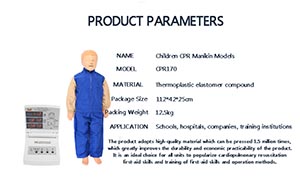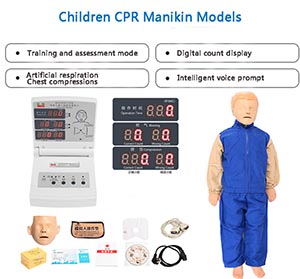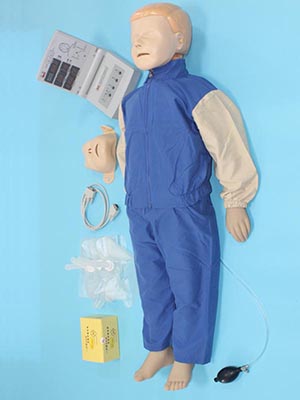Welcome to visitShanghai Chinon medical Model & Equipment Manufacturing Co., LTD
Advanced child cardiopulmonary resuscitation (CPR) simulators are an integral part of modern medical training and play an important role in improving the efficiency of first aid and reducing complications and mortality after cardiac arrest in children. The following will explore the unique value of this device in first aid training from the key areas of professional training, intelligent feedback systems, simulation scenarios and data analysis.

1. Provide a realistic professional training experience
The Advanced Children's CPR Simulator provides a near-real operating environment for medical staff and trainees through highly simulated anatomical and physiological design:
- Anatomical design: Simulate human to accurately reproduce children's chest elasticity, airway structure and cardiopulmonary characteristics, so that students can intuitively feel the depth of pressure and ventilation resistance.
- Multi-age selection: From infants to teenagers, different models of simulators can adapt to the first aid needs of various childhood stages, and enhance the adaptability of students.
According to a study in Advances in Emergency Technology, CPR training using advanced child simulators improved the accuracy of compressions by about 35 percent over traditional methods.
2. Intelligent feedback system to optimize operation
Modern Advanced Children's SIMS integrate a variety of real-time feedback systems to help students continuously adjust and refine their techniques:
Compressions and ventilation feedback: The device uses sensors to monitor the depth, frequency, and position of compressions to indicate whether American Heart Association (AHA) standards are being met (e.g., 100-120 compressions per minute).
Audio and visual cues: Many simulators give direct feedback via a screen or light on whether the operation is correct, such as whether ventilation causes gas to enter the stomach.
- Intelligent evaluation report: Generate an operational report after the training to quantify student performance, such as the average depth of compressions and airway opening success rate.
Research has shown that devices with real-time feedback can improve skill mastery by 40-50% and significantly reduce error rates.

3. Restore the first aid scene and improve the strain capacity
First aid for children is often complex and unpredictable. Advanced CPR simulators support a variety of first aid scenarios to make training closer to clinical practice:
- Simulate choking or airway obstruction: The device can simulate a real choking scenario by adjusting airway patency to help students master airway foreign body removal skills.
- Changes in vital signs: Some high-end devices can simulate real-time changes in parameters such as heart rate and breathing to reflect the evolution of the disease during resuscitation.
- Team exercise: Through the networking function, multiple students can conduct team cooperation training on the simulator, covering the whole process operations such as chest compression, ventilation, and drug delivery.
A study by a first aid training institute found that the response time to emergencies in the clinic was reduced by an average of 30% after the scenario simulation training.

4. Data analysis drives personalized training
The large amount of operational data generated by advanced children's SIMS provides a scientific basis for optimizing training content and methods:
- Personalized feedback: According to the historical operation data of the trainees, the equipment can customize the training difficulty and scene.
- Team performance analysis: Help optimize first aid process and division of labor by analyzing team cooperation efficiency.
- Long-term skills assessment: The training institution can use the data recorded by the simulator to track the technical progress of the trainees and ensure that they have a stable first aid ability.
Data shows that CPR simulators incorporating data analytics have improved the overall performance efficiency of emergency teams by 25%.
Summary: Key help to hit the pain point
Advanced Child CPR simulators provide support in improving first aid skills and real-world resilience:
1. High simulation design to ensure the accuracy of technical learning.
2. Intelligent feedback and real-time data to help students optimize operations.
3. Multi-scenario simulation to enhance students' ability to deal with complex first aid incidents.
4. Data-driven training to promote personalization and team collaboration.
For professional first aid training institutions and medical institutions, advanced children's simulators are not only teaching equipment, but also a bridge connecting theory and practice through data and technology. It provides a low-risk, high-performance learning platform for first responders with the ultimate goal of protecting more children's lives and reducing errors and delays in first aid.
|
NEXTпјҡCan human acupuncture Model Man help you improve your healing skills?
LASTпјҡWhy is the advanced infant head venipentesis training model a concern? |
Return list |